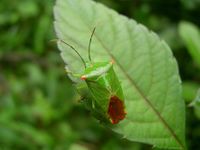پنتاتومويديا
| Shield and stink bugs | |
|---|---|

| |
| Acanthosoma labiduroides female | |
| التصنيف العلمي | |
| مملكة: | |
| Phylum: | |
| Class: | |
| Order: | |
| Infraorder: | |
| Superfamily: | Pentatomoidea
|
| Families | |
| |
پنتاتومويديا Pentatomoidea، هي فوق فصيلة من الحشرات في تحت رتبة متغايرات الأجنحة Heteroptera من رتبة نصفيات الأجنحة Hemiptera، share a common arrangement of sucking mouthparts.[1] وتعرف هذه الأنواع من الحشرات باسم بق الدرع shield bugs, chust bugs, and stink bugs. Shield bugs have glands in their thorax between the first and second pair of legs which produce a foul smelling liquid. This liquid is used defensively to deter potential predators and is sometimes released when the bugs are handled carelessly. The distinctive smell comes from aldehydes such as CH3–(CH2)2–CH=CH–CHO.
The nymphs, similar to adults except smaller and without wings, also have stink glands.
The nymphs and adults have piercing mouthparts which most use to suck sap from plants, although some eat other insects. When they group in large numbers they can become significant pests.
Other species that resemble pentatomoids are found in the superfamily Coreoidea.
الموطن
يوجد في الجزر البريطانية 33 نوع من بق الدرع ينتمون للفصيلة الفرعية پنتاتومويديا، 32 موطنهم الأصلي الجزر البريطانية ونوع واحد فقط مستجد.[2] Of these 32 species, 17 belong in the family Pentatomidae. Stink bugs hibernate in the winter.
During warm months, female stink bugs attach large masses of eggs to the underside of leaves and stems. After hatching, the wingless nymphs go through five immature stages before becoming full-sized, winged adults. Stink bugs are not known to bite humans but caution should be used when handling them to avoid a release of their odor. If the bug releases its odour by way of spraying a fine mist, the mist can cause burning to the eyes which may result in abrasions to the cornea. If sprayed in the eyes, immediately flush the eyes with water and seek medical advice.
الفصائل
In Britain the families encountered are Cydnidae, Acanthosomatidae, Pentatomidae and Scutelleridae.[3]
Lestoniidae is a small family group comprising only two species endemic to the Australia. [4]
The Canopidae and Phloeidae are found strictly in the Neotropical ecozone [5]
The Dinidoridae can be found in the Afrotropical and Oriental regions (including Korea); South America and Australia.[6]
Megarididae have been documented only in Central America.[7]
Plataspididae are restricted to the tropics and sub tropics of the Eastern Hemisphere although a few species of Coptosoma occur in the Palearctic.[8]
Tessaratomidae are centred mainly in the Old World tropics and there is some evidence of parental care in this group.[9]
Thaumastellidae are limited to the Afrotropical and Palearctic regions. There is some debate to their inclusion within Pentatomoidea.[10]
Urostylididae are predominantly found in the eastern palearctic ecozone[11] (including Korea).
انظر أيضا
المصادر
- ^ "Hemiptera: bugs, aphids and cicadas". CSIRO. Retrieved 2007-05-08.
- ^ Evans, Martin (2005). A Photographic Guide to the Shieldbugs and Squashbugs of the British Isles. Wakefield: WGUK. ISBN 0-9549506-0-7.
{{cite book}}: Unknown parameter|coauthors=ignored (|author=suggested) (help) - ^ www.earthlife.net
- ^ P136 Christopher G. Morris Academic Press dictionary of science and technology, Gulf Professional Publishing, 1992, ISBN 0-12-200400-0
- ^ P220 Randall T. Schuh, James Alexander Slater, True bugs of the world (Hemiptera:Heteroptera): classification and natural history, Cornell University Press, 1995, ISBN 0-8014-2066-0
- ^ P415 Zoological Catalogue of Australia: Hemiptera, Heteroptera, Pentatomomorpha Volume 27, Editor Australian Biological Resources Study, CSIRO Publishing, 2002 ISBN 0-643-06875-9
- ^ www.discoverlife.org
- ^ P76 Randall
- ^ P311, James T. Costa, The other insect societies; Belknap Press Series Harvard University Press, 2006 ISBN 0-674-02163-0
- ^ P353 Zoological Catalogue of Australia
- ^ Robert G. Foottit, Peter H. Adler Insect Biodiversity: Science and Society, John Wiley and Sons, 2009, ISBN 1-4051-5142-0

